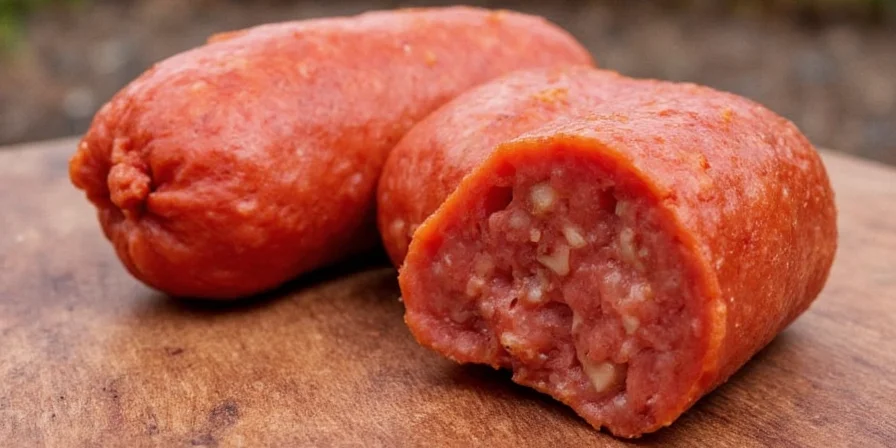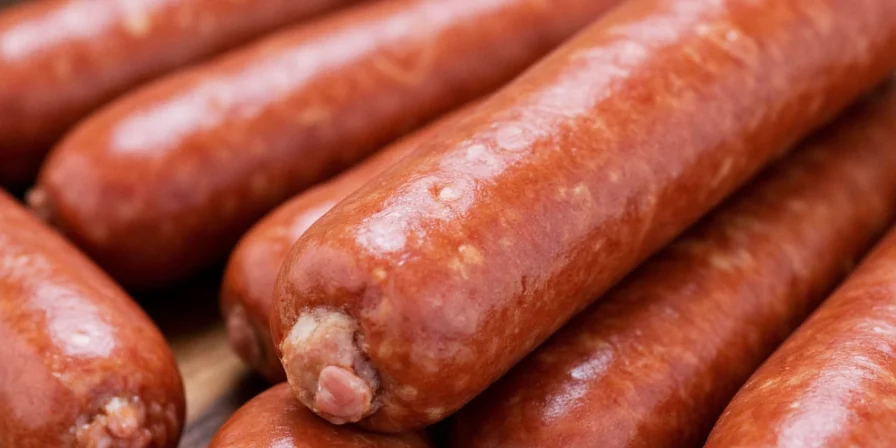Chorizo contains pork, smoked paprika (pimentón), garlic, salt, vinegar or wine, and regional spices. Spanish chorizo is cured and ready-to-eat with a 3:1 paprika-to-garlic ratio, while Mexican chorizo requires cooking and uses fresh chilies with 3% garlic content. Both types typically contain 80% fat ratio pork as the base.
Discover exactly what gives chorizo its signature red color and smoky flavor, why Spanish and Mexican versions behave differently in cooking, and what ingredients to check for dietary needs. This complete breakdown answers the most searched questions about chorizo ingredients in 2025.
Table of Contents
- What Is Chorizo? Basic Definition
- Core Chorizo Ingredients List
- Spice Blends That Create Flavor
- Spanish vs Mexican Chorizo Ingredients
- Common Ingredient Questions Answered
- Ingredient Substitutes When Needed
What Is Chorizo? Basic Definition
Chorizo is a highly seasoned sausage made from pork, smoked paprika, garlic, and salt. The two main types are Spanish chorizo (cured and ready-to-eat) and Mexican chorizo (fresh, requiring cooking). Understanding what's in chorizo helps prevent cooking mistakes and selects the right type for your recipe.
Unlike generic spicy sausages, authentic chorizo contains specific regional ingredients that create its distinctive red color and complex flavor profile. What gives chorizo its red color? Primarily smoked paprika (pimentón) in Spanish versions and fresh chilies in Mexican varieties.
Core Chorizo Ingredients List
Every authentic chorizo contains these essential components. The precise ratios vary by region but these elements form the foundation:
| Ingredient | Typical Percentage | Purpose in Chorizo |
|---|---|---|
| Pork (high-fat ratio) | 70-80% | Primary meat base carrying flavors |
| Smoked Paprika (Pimentón) | 5-10% (Spanish) | Signature red color and smoky flavor |
| Fresh Garlic | 1.5-3% | Aromatic foundation and preservative |
| Salt | 2-3% | Flavor enhancer and preservative |
| Vinegar or Wine | 3-5% | pH regulator and flavor balancer |
| Regional Spices | 1-5% | Cultural flavor signatures |
Spice Blends That Create Flavor
What makes chorizo taste different from other sausages? The precise spice combinations:
- Spanish Pimentón: Made from oak-smoked peppers, creating complex smoky notes. Dulce (sweet) and Picante (spicy) varieties determine heat level.
- Mexican Chili Blend: Uses fresh guajillo or arbol chilies instead of smoked paprika, providing fruitier heat.
- Garlic Content: Spanish versions use 1.5% garlic while Mexican uses 3%, creating distinct aroma profiles.
- Secret Ingredient: Some Spanish recipes include 0.5% cinnamon (Moorish influence) that enhances sweetness without detectable spice notes.

Spanish vs Mexican Chorizo Ingredients
Understanding the ingredient differences prevents cooking failures. The key distinctions:
| Characteristic | Spanish Chorizo | Mexican Chorizo |
|---|---|---|
| Meat Preparation | Dry-cured (25% moisture loss) | Raw, high-fat emulsion (30%+ fat) |
| Primary Color Source | Smoked paprika (pimentón) | Fresh red chilies (guajillo/arbol) |
| Acid Component | Wine (2-3%) | Vinegar (5-6% acidity) |
| Cooking Requirement | Ready-to-eat (no cooking) | Must be fully cooked |
| Shelf Life (Opened) | 6 weeks refrigerated | 2 days refrigerated |

Common Ingredient Questions Answered
What people really want to know about chorizo ingredients:
Does chorizo contain nitrates?
Traditional chorizo uses salt and smoke for preservation, avoiding synthetic nitrates. Check labels for "no added nitrates"—many artisanal brands follow historical methods. Mass-produced versions may contain sodium nitrite for color stabilization.
What gives chorizo its red color?
Spanish chorizo gets its vibrant red from pimentón (smoked paprika), while Mexican chorizo uses fresh red chilies. Annatto seeds are sometimes added for additional coloring and antioxidant properties.
Is chorizo just spicy sausage?
No—chorizo's unique flavor comes from specific regional spice blends, not just heat. Spanish chorizo features smoky depth from oak-smoked peppers, while Mexican chorizo balances chili heat with vinegar's acidity. The precise spice ratios create its distinctive profile.
Why does my chorizo turn gray when cooked?
High cooking temperatures (above 350°F) cause paprika's pigments to degrade. Cook Mexican chorizo between 325°F-350°F for optimal color retention. Spanish chorizo shouldn't be cooked at all as it's ready-to-eat.
Does chorizo contain gluten or dairy?
Traditional chorizo contains neither gluten nor dairy. However, some mass-produced versions may include fillers. Always check labels if you have allergies—authentic recipes only contain meat, spices, salt, and acid.
What's the fat content in chorizo?
Chorizo typically contains 30-40% fat (70-80% lean meat). This high fat ratio carries flavors and creates the characteristic texture. When cooking Mexican chorizo, 70% of this fat should render out for best results.
Ingredient Substitutes When Needed
Can't find chorizo? These ingredient swaps maintain flavor integrity:
- Spanish-Style Substitute: Mix salami (for texture) with smoked paprika (2 tsp per 8oz) and sherry vinegar (1 tsp)
- Mexican-Style Substitute: Combine ground pork with smoked paprika (1 tbsp), vinegar (1 tsp), and crushed arbol chilies (1/2 tsp)
- Vegan Option: Use textured vegetable protein with annatto oil (for color) and liquid smoke (3 drops)
- Quick Alternative: Crumble pepperoni into hot pan—similar fat composition mimics chorizo's rendering behavior

Conclusion
Knowing exactly what's in chorizo helps you select the right type for your cooking needs and avoid common mistakes. The key differences lie in the spice blends (smoked paprika vs fresh chilies), preparation methods (cured vs fresh), and specific ingredient ratios that create each variety's distinctive profile.
When checking chorizo ingredients, focus on the meat-to-spice ratio, acid component, and whether it contains any additives. Authentic versions should list simple, recognizable ingredients without artificial preservatives. This knowledge transforms how you use chorizo in recipes and ensures you get the flavor experience you're seeking.












 浙公网安备
33010002000092号
浙公网安备
33010002000092号 浙B2-20120091-4
浙B2-20120091-4